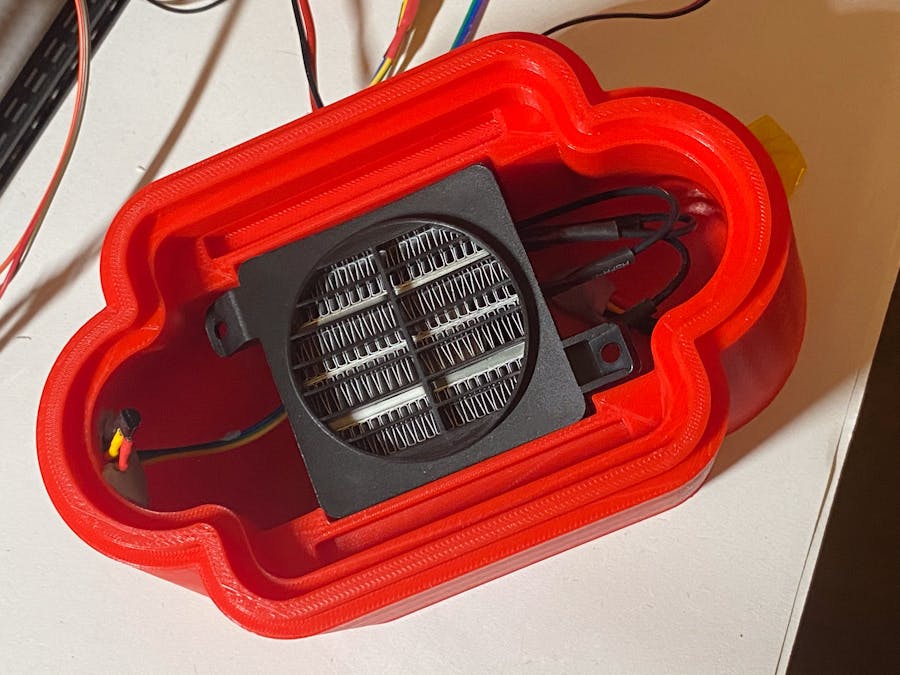To improve Mk III air heated microreactor. Details of the reactor design can be found at: https://www.hackster.io/jim-haseloff/modular-microreactors-5becf0 - and a general overview of the OpenPlant Biomaker-sponsored initiative found at: https://www.biomaker.org/covid19.
(i) Test reversed air flow through PTC heater- StarTech heatsink combination by reversing orientation of the standard Evercool fan - to drag air through the heatsink, and blow heated air directly over reaction tubes.
(ii) Test replacement of standard 10mm thick Evercool fan with up to 25mm thick higher power fans, to improve air flow. This requires the modifcation of the vessel base.
(iii) Optimise settings for printing with nylon.
(iv) Print new vessel parts with nylon filament for higher temperature resistance.
(v) Test the thermal properties of nylon parts.
(vi) Test reactor with higher power heater element
(vii) Modify base for the addition of a thermoelectric cooler - which requires dual thermal control systems, but allows heating and cooling via H-bridge switching and Arduino control.
(viii) Develop new XOD-based sofware control system, incorporating PID and reverse-cycle heating/cooling.
1. Air flow.The Mk III prototype uses a StarTech copper heatsink with attached 60x60x10mm high speed (4800 rpm) Evercool fan (EC6010HH12CA). This fan shifts 20.26 CFM (cubic feet per minute), and is orientated to force air through the heatsink fins. In the reactor, this drags air past the reaction tubes, and forces it downwards into the heatsink - where the fins direct the air flow laterally, to the two side channels.
The reactor was run in this configuration to a setpoint of 60ºC, and then the heatsink-fan was removed and reversed in orientation, so that the flow of air was upwards. The fan was positioned to draw air from the base of the reactor, through the heatsink fins, and directly onto the reaction tubes. The time taken to heat the vessel to 60ºC was measured, along with temperature oscillations around the set point.
Thermal behaviour of the Mk III microreactor (with 50% octet infill pattern) and standard StarTech heatsink-fan, showing oscillating temperature at the 60ºC setpoint (19 min, 52 sec to reach 60ºC air temperature, then heats 50 sec on - 40 sec off, heater temperature oscillates between ~63-70ºC). Shown above. The vessel contains three installed DS18B20 temperature sensors, one attached to the heating element (blue), one exposed to air in the sample area (white) and one in air in the base of the reactor (red). The white and red traces coincide if the air temperatures match.
The Mk III reactor vessel is well insulated - here showing where the heater is unplugged, and the air temperature cools by about 1ºC per minute (the graticule divisions are 20 sec apart on the X axis, 10ºC apart on the Y axis). See above.
To give an indication of heat loss through venting to the exterior, the vessel lid was removed, allowing faster cooling - up to 15º per minute.
2. Reversing the air flowThe standard 60x60x10mm fan on the StarTech heatsink was removed and rebolted to the heatsink in the opposite orientation. This required the use of longer 25mm M3 bolts and use of spacers (M3 washers) to avoid contact between the fan blades and heatsink fins. The heatsink-fan was then reinstalled, and created a reversed airflow through the vessel.
The vessel with reversed airflow was plugged into the control unit (https://www.hackster.io/jim-haseloff/programmable-test-rig-d7df62), and powered with software control (https://www.hackster.io/jim-haseloff/heatsinks-for-microreactor-temperature-control-65ecfa) to reach the 60ºC setpoint.
The air temperature in the vessel with reversed airflow reached 60ºC in 20 min 49 sec, about a minute slower than the Mk III vessel with the standard heatsink-fan arrangement, and oscillated at the setpoint with the heater 65 sec on - 65 sec off, while the heater temperature cycling between ~63ºC and 75ºC. The temperature sensor in the base consistently registered ~1.5ºC higher, which might reflect heat buildup in the lower part of the reactor (around the heater) due to reversal of the airflow.
3. Higher airflowsThe prototype uses a StarTech copper heatsink with attached 60x60x10mm high speed Evercool fan (EC6010HH12CA) rated at 12V, 0.22A. This fan has a single ball-type bearing, rotates at 4800 rpm, shifts 20.26 CFM (cubic feet per minute) or 11.9 cubic metres per second. One of the useful features of the heatsink-fan is that the fan is attached through a standard mount, so can be easily replaced by any other 60mm axial fan with the usual 50mm-spaced mounting points. A number of relatively low-cost 60mm fans are available, which can be used for higher rates of airflow and/or work with higher static pressures. These more powerful fans generally come in thicker sizes. For example, there are a wide variety of faster/stronger fans available in the 60x60x25mm size format. Specifications for several are shown below:
Different fan blade patterns for (i) standard StarTech heatsink fan (Evercool 6010 - top left), (ii) Noctua NF-A6x25 (top right), (iii) ARX 6025V 6, 500rpm (bottom left) and (iv) ARX 6025V 7, 000 rpm (bottom right).
The replacement of the 60mm axial fan with a higher power 25mm version requires some adjustment of the reactor base, to accommodate the larger assembly. The necessary adjustments were made in Fusion 360, and printed on the Ultimaker S3. The designs looked like the following:
As well as having a taller base unit (to accommodate the larger fan units), the redesigned reactors were adjusted to have (i) a larger headspace. to allow options for less impeded airflow and/or space for redesigned reaction blocks (shown in green), and (ii) the bases of the side channels, inside the reactor, were made more aerodynamic, with smoothed profiles.
A prototype was printed in Ultimaker Tough PLA with a setting of 30% infill density, and a 3D cubic pattern. The print took 19 hours to finish in Cura draft mode. A comparison of the printed taller base with the Mk III prototype is shown below.
The new taller housing was used to install the StarTech heatsink with the different types of fans described above. These were assembled with PTC heater and thermal sensors, and run to a setpoint temperature of 60ºC. The higher performing combinations were tested with the fans (i) first orientated to blow downwards onto the heatsinks, and (ii) in a second test, orientated to blow upwards onto the reaction tubes.
Noctua NF-A6x25 fan - downwards
Noctua NF-A6x25 fan - upwards
The Noctua fan has a relatively low rotation speed, with a noticeably lower flow rate. It took over 25 minutes for the vessel to warm from room temperature to 60ºC. There was not a major difference between the different directions of airflow.
ARX 6025V 6, 500rpm fan - downwards
ARX 6025V 6, 500rpm fan - upwards
ARX 6025V 7, 000 rpm fan - downwards
ARX 6025V 7, 000 rpm fan - upwards
The higher airflow of the two ARX fans results in shorter heating times to reach the 60ºC set point (11-13 min). At steady-state, shorter heating times were required to maintain temperatures, compared to the slower speed fan. This points to the importance of high rates of airflow for thermal exchange, mediated by forced air convection.
5. Higher power PTC heaterCeramic PTC heaters are used for warming small volumes like car interiors, and integrated fan heater devices are available on Amazon, Ebay, AliExpress, etc. For example, 12V, 100-120W fan heaters are available for as low as less than £10. These use 60mm fans to drive heat exchange, and fit neatly into the new, taller Mk IV microreactor prototype. This is a cost effective way of obtaining a fan and heat source. The power output of these devices is considerably higher than the PTC elements I have used so far.
A ceramic PTC car heater (https://www.amazon.co.uk/gp/product/B07JHQKXFR, £10.99) was installed in the Mk IV base, along with thermal sensors. The heater and fan connections are compatible with the 12V switched control systems for other PTC and fans that we have used. The car heater-fan devices were hooked up to the standard test rig, vessels closed, and run to the 60ºC setpoint.
The use of the higher power car heater device results in much faster heating times. Temperatures in the reactor reach 60ºC from room temperature in less than 2 min, with very short heating pulses (5-10 sec) seen at steady state. The compact air heater (60x60x42mm) was mounted in both downward and upward pointing directions.
Car air heater - orientated downward
Car air heater - orientated upwards
The
Next steps:The higher power air heater provides much faster - around 10x shorter heating times to reaction temperatures suitable for biological diagnostic reactions. The component will be incorporated into the next generation of micro reactors - with the following developments:
(i) Reaction vessels are printed from nylon to provide higher heat resistance, to allow reaction temperatures up to 95ºC (required fro DNA denaturation during PCR amplification.
(ii) The car heater unit contains an integrated 60mm axial fan with standard mounts. This can be upgraded to a higher power fan to allow faster airflow through the micro reactor, and most efficient and even heat transfer.
(iii) The use of a faster, higher power heater necessitates the adjustment of the software controller, to allow faster reading of temperatures, to allow more accurate control of the heater (using PID logic).
(iv) I plan to incorporate intake and exhaust fans and suitable control software - in addition to the the heat recycling system, to allow thermal cycling reactions. This would allow construction of simple instruments of the type required for PCR and RT-PCR diagnostics and Type IIS DNA assembly - for ultra low cost.






_t9PF3orMPd.png?auto=compress%2Cformat&w=40&h=40&fit=fillmax&bg=fff&dpr=2)




Comments
Please log in or sign up to comment.